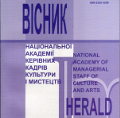ТРАВМА & ІСТЕРІЯ В ЄВРОПЕЙСЬКІЙ КУЛЬТУРІ FIN DE SIÈCLE (ЧАСТИНА 2)
TRAUMA & HYSTERIA IN FIN DE SIÈCLE EUROPEAN CULTURE (PART 2)
Author(s): Olha KopiievskaSubject(s): Theatre, Dance, Performing Arts, Photography, Aesthetics, Psychology of Self, Clinical psychology, Sociology of Culture
Published by: Національна академія керівних кадрів культури і мистецтв
Keywords: trauma; hysteria; problematisation of trauma & hysteria; mental illness; aestheticisation; theatricalisation; photography; commodification; European culture; fin de siècle;
Summary/Abstract: The purpose of the article is to analyse the reasons for the actualisation of the issues of trauma and hysteria in the European culture of the fin de siècle; to identify the role of aesthetisation, theatricalisation and photography in the commodification of mental illness. The research methodology includes the general scientific principles of systematisation and generalisation of the problem under study, which made it possible to identify and scientifically substantiate existing theories and conceptual approaches to understanding the content of the concepts of "trauma", "psychological trauma", "hysteria", "mental illness". The application of the axiological approach made it possible to identify interdisciplinary nature and personalised cultural scientific positions in the theories under consideration. The use of the analytical method led to the establishment of conceptual foundations for further scientific perspectives on the problematisation of trauma, psychological trauma, hysteria as mental illnesses in the optics of cultural knowledge. The scientific novelty lies in the implementation of cultural reflection to clarify the socio-cultural determinants of the spread of hysteria and psychological trauma as mental illnesses. Conclusions. The article deals with the issues related to the understanding of the content of hysteria and trauma in the culture of the late nineteenth and early twentieth centuries not as purely medical, but as socio-cultural phenomena. The aestheticisation, theatricalisation, and commodification of mental illnesses, initiated by the example of J.-M. Charcot's hysteria, actualised and stimulated their discussion from new perspectives, opened up new discursive spaces of research: psychoanalytic, social, artistic, aesthetic, which did not exist in their pure form but were combined with each other. In the fin de siècle culture, hysteria and trauma are embedded in the structure of the subjective and are defined through processes, events and human perception as a special idea of internalising the world, where the thanatological problematic represents a fundamental feature of culture associated with the anticipation and expectation of the approach of death, with being within the "finitude of human life"; and artistic representations of a split, "hysterical", traumatised personality are embodied in the works of European painters, sculptors, and writers. Photography, as a new way of seeing the world, social and individual existence, symbolised and expressed the connection between science and art, expanded the range of human emotional states and contributed to the commodification of hysteria in the "theatrical spectacles" presented at the Salpetriere Hospital.
Journal: Вісник Національної академії керівних кадрів культури і мистецтв
- Issue Year: 2023
- Issue No: 4
- Page Range: 3-8
- Page Count: 6
- Language: Ukrainian

